Know the Nutrients in Your Hay, Enabling a More Insightful & Efficient Way to Feed Your Horse
Hay is a main source of forage for many horses, and knowing what nutrients it offers allows horse owners and caretakers a better understanding of what else needs to be provided in the diet for optimal nutritional health. A detailed analysis can be done for all forages, including pasture and hay, and provides valuable information about digestibility and calorie content, protein levels, mineral concentrations as well as the content of sugars and starches. If you purchase hay to last more than a couple of months at a time, or if you grow hay yourself, a hay analysis can be helpful to know more precisely what you are feeding. An analysis can be especially useful for horses with health issues and is commonly recommended in such cases to make sure the diet is well balanced for disease management. Whether it is for peace of mind or general interest, a hay analysis is a good snapshot of the nutrient content for this important dietary staple.
Interpreting a hay analysis can seem daunting at first due to many terms and acronyms used in the report that are not otherwise seen even on commercial feed tags, labels and guaranteed analyses. Local extension services may offer a forage analysis, or hay or pasture samples can be sent to a laboratory that specializes in these types of analyses such as Equi-Analytical Laboratories (equi-analytical.com).
“As Sampled” vs “Dry Matter”
At the top of the analysis report you will see the value of moisture, which is the percent of water in the hay. All hay will contain some moisture, typically about 10 percent. A significantly higher moisture level may indicate a higher risk for mold or heating in the hay bales. Haylage, a common preserved forage in many parts of the world and gaining interest in the United States, will have a higher moisture content (15-40 percent) as fresh cut hay is sealed in an anaerobic environment allowing the natural microbes to ferment the grass sugars. The dry matter portion is the percent of the hay that is not water and includes the protein, fat, mineral, carbohydrate and fiber content. Most dried hay contains approximately 90 percent dry matter. Many analyses will have two columns: an “as sampled” column and a “dry matter” (DM) column. The difference between the two columns and nutrient values that are in the analysis report is that the “as sampled” values contain the water and moisture content of the hay together. This is the natural state of the forage that the horse will actually eat. The dry matter analysis has the moisture content removed from the sample values. Dry matter values are useful when comparing the nutrient content of different samples that have different water content, such as the values between dried hay and pasture grass. Either the “as sampled” or “dry matter” nutrient values can be used to balance a ration, if the feeds contain a similar dry matter content. The same column should be used consistently to prevent comparative errors.
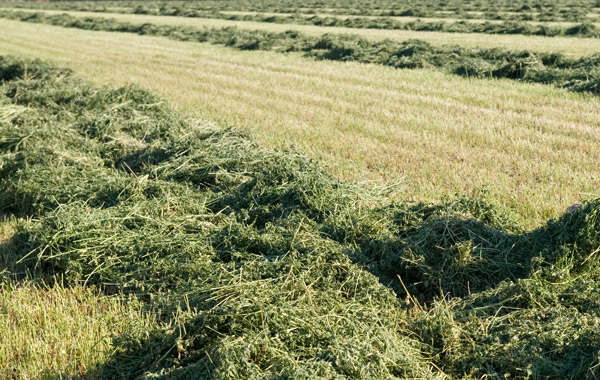
Pasture and hay should make up the majority of any equine diet, and knowing what else is needed to complement a forage-based diet can take the guesswork out of feeding grain and concentrates, commercial feeds and supplements.
Digestible Energy, Crude Protein & Lysine
The digestible energy (DE) is the calorie yield of the hay and is usually listed in megacalories per pound or Mcal/lb. This is the measure of energy or “fuel” that the hay is providing. On an as-sampled basis, hays typically range from 0.6-1.1 DE per pound depending on plant type and maturity. For reference, a 1,100-pound (500 kg) horse at maintenance requires an average of 16.7 Mcal DE daily. Crude protein is a measurement of nitrogen and an estimate of the total protein content of the hay. Alfalfa hay tends to have higher crude protein levels ranging 15-22 percent compared to grass hays, which are typically lower averaging 7-14 percent, depending on stage of plant maturity when cut. If hay is below 10 percent crude protein, it may not meet protein requirements for a horse if hay is the only feed provided in the diet. For most adult horses, a crude protein concentration of 10-14 percent DM from hay will provide maintenance protein requirements when the hay is fed at 1.5-2 percent of the horse’s body weight. Crude protein content can also be one indicator of overall hay quality as grass or alfalfa hays with a 90 percent or higher dry matter content and harvested pre-bloom typically offer good digestibility and high quality or complete protein with all the necessary amino acids present. Lysine is an essential amino acid required for bone growth and muscle development and repair. Adequate lysine levels are particularly important in the diet of growing foals to facilitate normal growth and development. Lysine tends to be the most limiting amino acid; it will be the first one lacking in the diet. If there is not enough lysine available in the diet, the body will be unable to use the remaining amino acids to synthesize proteins as all amino acids are needed in appropriate quantities to build protein.
Nutrient Requirements for An Adult Horse
| AT MAINTENANCE (1,100 LB HORSE) | |
|---|---|
| Digestible Energy (DE) | 16.7 Mcal |
| Crude Protein | 630 g |
| Lysine | 27.1 g |
| Calcium (Ca) | 20.0 g |
| Phosphorus (P) | 14.0 g |
| Sodium (Na)10.0 g | 10.0 g |
| Iron (Fe) | 400.0 mg |
| Zinc (Zn) | 400.0 mg |
| Copper (Cu) | 100.0 mg |
| Selenium (Se) | 1.0 mg |
Sample Hay Analysis: Timothy DM
| FEEDING AN 1,100 LB HORSE 2% OF HIS BODY WEIGHT (22 LBS HAY) | |
|---|---|
| DE 1.03 Mcal/lb x 22 = | 22.66 Mcal |
| CP 48.5 g/lb x 22 = | 1,067 g |
| Lysine 1.7 g/lb x 22 = | 37.4 g |
| NSC (WSC + Starch) = 18.5 + 1.1 = | 19.6% |
| Calcium 1.62 g/lb x 22 = | 35.64 g |
| Phosphorus 1.10 x 22 = | 24.2 g |
| Sodium .088 x 22 = | 1.94 g |
| Iron 61 mg/lb x 22 = | 1,342 mg |
| Zinc 18 mg/lb x 22 = | 396 mg |
| Copper 4 mg/lb x 22 = | 88 mg |
| Selenium .01 ppm = .01 mg/ 2.2 lbs = .0045 mg/lb x 22 = |
0.1 mg |
Platinum Performance® Equine can help supplement common deficiencies and ensure your horse’s nutritional requirements are met. For example, the above Sample Hay Analysis is deficient in zinc and copper, but nutritional requirements are met when Platinum Performance® Equine is added to the ration.
Requirement Hay + Platinum Performance® Equine
Zinc 400 mg 396 mg + 120 mg = 446 mg
Copper 100 mg 88 mg + 14 mg = 102 mg
Acid Detergent Fiber & Neutral Detergent Fiber
Lignin, acid detergent fiber (ADF) and neutral detergent fiber (NDF) are different measurements of structural carbohydrate fractions that are reported as percentages on a forage analysis to quantify the structural or cell wall portions in the forage. There are three main structural fiber components that are important on the analysis, and they include lignin, cellulose and hemicellulose. Lignin is an indigestible plant component of plant cell walls; even the fiber- digesting hindgut microflora are unable to break it down into a digestible fiber. As plants mature their lignin content increases. More mature cuts of hay will contain higher levels of lignin and will be less digestible compared to hay containing younger plants. ADF is a measure of cellulose and lignin. Cellulose digestibility is negatively correlated to lignin levels. As lignin content increases, digestibility of cellulose decreases, which lowers the amount of energy potentially available to the horse. Hays with an ADF value between 25-35 percent are considered higher quality, while hays that have an ADF between 35-45 percent are considered to be of lower relative quality. ADF can be a useful gauge to help determine the general digestibility of hay. The NDF value is the best indicator of the total fiber content of the hay because it includes all of the cell wall carbohydrates: lignin, cellulose and hemicellulose. Hemicellulose is the most readily fermented structural fiber fraction and is capable of providing the most energy to the horse. NDF values can be used to estimate forage intake potential. The higher the NDF concentration, the less hay is likely to be consumed by a horse. Higher quality hays will have an NDF in the 35-55 percent range; lower quality hays averaging 55-70 percent. When the concentration of NDF increases above 55 percent, the hay may not provide adequate digestible nutrients, and a horse may need to be fed a higher volume of hay or may need to be supplemented with more energy dense feeds. High-quality hay is good for horses with energy demanding jobs, horses with increased nutrient requirements due to life stage (growth, pregnancy, lactation) and horses that need to maintain or gain weight. Lower quality hays can be beneficial for horses that require less energy because the hay will still provide a necessary source of long-stem fiber to help promote gastrointestinal health. For example, an overweight horse may do very well on a less “quality” hay where calories and protein provided are lower and fiber content is higher, but the horse can still consume it throughout the day for digestive health without consuming excess calories.
Understanding Carbohydrate Concentration
The non-structural carbohydrate (NSC) concentration in hay is a general measurement of the sugar, starch and fructan concentration in forage. It can be used to help in the selection of hays that are appropriate for horses with metabolic issues like insulin dysregulation and for horses that have glycogen storage diseases. Horses that require a ration that is limited in starch and sugar should be fed a forage with an NSC concentration that is between 10-12 percent or below. A limit to using the NSC value for a forage is that it does not account for the specific sugar and starch content of a forage, which influences the location in the gastrointestinal tract where the carbohydrates are digested. For example, sugars and starches are enzymatically digested in the small intestine, while fructan is digested by rapid fermentation in the hindgut. An alternative way to measure these specific carbohydrate fractions that is offered by many forage analysis companies is to measure the water soluble carbohydrate (WSC), ethanol soluble carbohydrate (ESC) and starch components. Water soluble carbohydrates include a combination of fructan and simple sugars, including monosaccharides and disaccharides. Ethanol soluble carbohydrates include only simple sugars; those that are broken down in the small intestine. Since the ESC does not include fructan, it can give a better estimate of a glycemic response from a hay. The starch percentage of the hay is also important because it can have a profound effect on blood glucose and insulin levels. Although starch can be rapidly fermented in the cecum, in moderate dietary amounts it is normally digested in the small intestine down to glucose and absorbed into the blood. The percentage of NSC can be calculated by adding WSC and starch values on the analysis. Limiting sugar and starch intake can be important for a variety of health conditions including obesity, insulin resistance, metabolic syndrome, chronic colic, laminitis, developmental orthopedic diseases, polysaccharide storage myopathy and recurrent exertional rhabdomyolysis. For horses that may have one of these diseases, restricting ESC and starch intake can be an important part of their medical management. For horses prone to pasture-associated laminitis, the fructan level should also be taken into consideration and can be estimated by subtracting the concentration of ESC from the WSC concentration. A final value that may be listed on a forage analysis is the NFC or non-fiber carbohydrate fraction. The NFC is not determined by chemical analysis but rather is calculated by the difference of other analysis components (100 – Moisture% – Crude Protein% – NDF% – Fat% – Ash%) and includes all of the digestible and easily fermentable carbohydrates that are not part of the cell wall including sugars, starches, fructan, pectin, beta-glucans and gums. A main difference between NFC and NSC is the level of water-soluble pectin. Although not found in the cell wall, pectin is still considered a fiber since it cannot be digested in the small intestine but can be fermented in the hindgut to produce calories.
How to Collect Forage Samples for Analysis
Hay Sampling
Step 1.Clearly label the plastic sample bag (at lease a quart size).
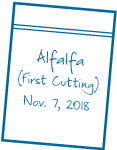
Step 2.Connect hay probe to a hand brace or an electric drill. Hay sampling tools can be purchased online.

Step 3.Randomly select 12-20 bales to probe to get a representative sample. Probe each bale in the center of the small end between the strings.
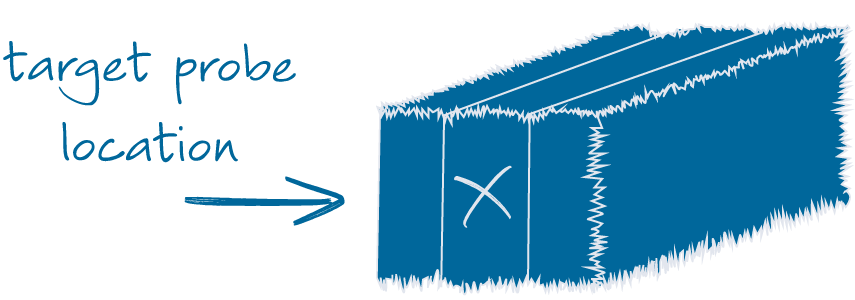
Step 4.After a bale is probed, separate the probe from the drill and plunge the core sample into the plastic bag. Repeat for each core sample.

Step 5.Complete the paperwork and send the sample package to the lab.

Pasture Sampling
Step 1.Clearly label the plastic sample bag (at lease a quart size).
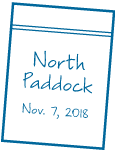
Step 2.Determine grazing height. Grazing Height = Height of Stubble Remaining After Grazing.
For example, if the height of the ungrazed grass is 10 inches and the horses are consuming only the top 6 inches, then the grazing height is 4 inches. Thus, when you clip your sample, you should only be clipping the top 6 inches for analysis.
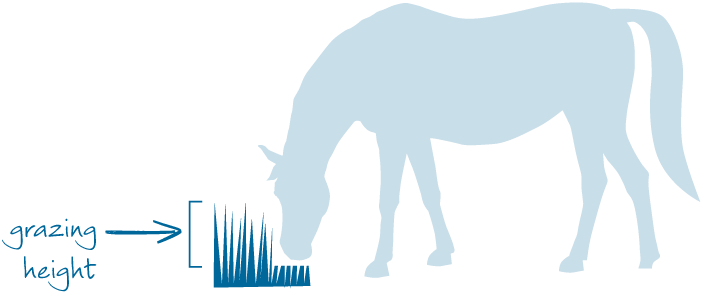
Step 3.Randomly select 12-20 sites in the pasture. Clip a handful of forage at grazing height at each site, cut into 1-2 inch strips and place clippings in a bucket.

Step 4.When clipping is completed, mix the sample thoroughly in a bucket, then pack the sample bag as full as possible (at least 1 lb). Freeze the sample overnight.

Step 5.Complete the paperwork and send the frozen sample package to the lab.

Hay and pasture samples can be sent to a laboratory that specializes in these types of analyses, such as Equi-Analytical Laboratories (equi-analytical.com).
Macro Minerals & Trace Minerals
Minerals in hay reflect the soil that the plant grew in. The total mineral content in a forage is reported as ash on the analysis. Macro mineral concentrations in the forage analysis are expressed as percentages (%) and grams per pound. Trace mineral concentrations are expressed as parts per million (ppm) and mg per pound, depending on the lab. The parts per million concentration is equivalent to a value of mg/kg or mg/2.2 lbs. All of the minerals that are reported on a forage analysis are essential nutrients that are necessary for overall health and, most importantly, must be available in the diet in adequate quantities to satisfy daily requirements. However, some are particularly important to note due to how they influence other minerals. The ratio of certain minerals needs to stay in a regulated balance. Ideally, calcium and phosphorus should be in a ratio of approximately 2:1 (2 parts calcium to 1 part phosphorus), although healthy adult horses can tolerate higher levels of dietary calcium. Many grass hays are naturally balanced at these levels. However, it is critical for phosphorus levels not to be higher than calcium and must be corrected if the ratio is inverted with more phosphorus than calcium. Most hays contain negligible amounts of sodium, and a plain, white salt block or access to free choice salt should be available to all horses along with fresh, clean water. Zinc and copper should ideally be kept near a 4:1 balance with more zinc than copper. Most forages are naturally high in dietary iron. Extremely high iron content can interfere with the absorption of other minerals, such as copper and zinc. If the concentration of iron is excessively high in a forage analysis, particularly a pasture analysis, there may be soil contamination of the sample. Selenium is an essential nutrient that is not included with a basic hay analysis package but may be worth including as an add-on if offered by the lab. Soil levels of selenium vary widely across the many different geographies of the United States and can be too low, or too high in some regions, potentially causing a toxicity even on a forage-only diet. Forage analysis companies may or may not report certain minerals on their individual reports, so it is worthwhile to check in advance what the analysis report will provide before the forage sample is submitted.
Did You Know?
Alfalfa hay tends to have higher crude protein levels ranging 15-22 percent compared to grass hays, which are typically lower averaging 7-14 percent, depending on stage of plant maturity when cut. If hay is below 10 percent crude protein, it may not meet protein requirements for a horse if hay is the only feed provided in the diet.
Nitrate
Nitrate is a nitrogen containing compound that can be toxic to horses if ingested in large enough quantities. Hays can become high in nitrate where fields have had excessive applications of nitrogen containing fertilizers or if the hay field is infested with weeds that are nitrate accumulators. A real problem in cattle, nitrite toxicity is uncommon in horses as they are less efficient than cattle at converting nitrate to nitrite in the digestive tract and likely to tolerate higher levels from forage. Care should be taken when feeding more than 1 percent nitrate DM.
Limitations of the Hay Analysis
The content of omega-3 fatty acids, as well as several vitamins including vitamin E and beta-carotene, the vitamin A precursor, drops significantly once hay is cut, cured and baled. Not just older bales but even fresher cut hays can be deficient in these important nutrients. Currently, forage analysis companies do not routinely perform an analysis to measure essential fatty acids or vitamins in forage. In order to ensure essential nutrient adequacy in the diet, a quality, comprehensive supplement offering vitamins, trace minerals, omega- 3 fatty acids and antioxidants like Platinum Performance® Equine can help ensure these nutrients are included in the diet.
Real Life Nutrition
Knowing how to interpret a hay analysis is useful when you are working to develop a feeding plan for your horse. A horse’s age, exercise status, stage of life, individual metabolism and health concerns must all be taken into consideration to determine the nutritional requirements of an individual horse. The 2007 Nutrient Requirements of Horses from the National Research Council (NRC) is a valuable resource for determining the concentration of different nutrients a horse requires. Available as a textbook and online (nrc88.nas.edu/nrh/), the Horse NRC provides charts of nutrient requirements by age and activity level and is the current gold standard for determining equine dietary needs. Whether you are interested in a specific mineral or you want to re-vamp your feeding program, the NRC serves as a helpful resource.
Quality forage goes a long way in fulfilling nutrient needs for most horses and should be considered the cornerstone of any feeding program. Pasture and hay should make up the majority of any equine diet, and knowing what else is needed to complement a forage-based diet can take the guesswork out of feeding grain and concentrates, commercial feeds and supplements. The hay analysis allows you to know the nutrients that are provided in your hay enabling a more insightful and efficient way to feed your horse.


by Emily Smith, MS,
Platinum Performance®
